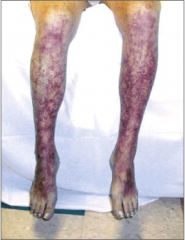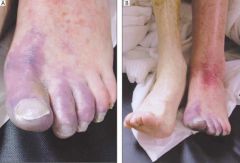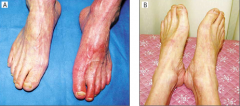![]()
![]()
![]()
Use LEFT and RIGHT arrow keys to navigate between flashcards;
Use UP and DOWN arrow keys to flip the card;
H to show hint;
A reads text to speech;
33 Cards in this Set
- Front
- Back
|
ECG finding of acute pericarditis?
|
Diffuse ST elevation and PR segment depression initially. With T wave depression later
|
|
|
Brugada syndrome?
|
Sudden cardiac death in Asian young man with RBBB and ST elevation in V1-V3
|
|
|
ECG finding of cocaine use?
|
ST elevation with early repolarization. Use of cocaine may lead to coronary thrombosis, vasospasm, arrhythmia, aortic dissection and accelerated atherosclerosis
|
|
|
ECG finding of major pulmonary embolism?
|
sinus tachycardia, RBBB, S wave in lead I, Q wave in lead III, or T wave inversion in lead III
|
|
|
Skin changes of amyloidosis?
|
Purpura & ecchymoses. Factor X binding by amyloid fibrils may be partly responsible
|
|
|
Common finding of antiphosholipid syndrome?
|
Stroke, recurrent pregnancy loss, livedo recitularis, purpura, thrombocytopenia, pulmonary embolism
|
|
|
Common finding of cryoglobulinemia?
|
Palpable purpura, Raynaud phenomenon, digital ischemia. Type I is associated with hyperviscosity and thrombosis
|
|
|
Common finding of hereditary hemorrhagic telangiectasia?
|
Mucosal and pulmonary AV malformation lead to epistaxis and GI bleeding, paradoxical embolism with stroke and brain abscess
|
|
|
Common finding of thrombotic thrombocytopenic purpura?
|
Anemia, hemolysis, thrombocytopenia, confusion, fever, renal involvement, myocardial infarction
|
|
|
What is the common cause of multifocal vascular lesion?
|
Vasculitis, e.g. cryoglobulinemia. SLE. Hypercoagulable state, e.g. antiphosholipid syndrome. Endocarditis and cholesterol emboli
|
|
|
How to manage suspected subacute endocarditis?
|
Culture three blood samples, drawn 1hr apart at separate sites. Start empirical board spectrum antibiotics once all blood sample have been obtained
|
|
|
What should be tested for culture-negative endocarditis?
|
Coxiella, Bartonella, Legionella, Clamydia species. HACEK bacteria (Haemophilus aphrophilus; Actinobacillus, cardiobacterium, Eikenella, Kingella)
|
|
|
Causes of painful purple toes?
|
Peripheral arterial disease; Cellulitis; Cryoglobulinemia Phlegmasia cerulae dolens
|
|
|
Classification of cryoglobulinemia?
|
Type I: monoclonal IgG or IgM, occurs in the presence of multiple myeloma or Waldenstrom's macroglobulinemia Type II: polyclonal IgG bound to monoclonal IgM. Associated with hepatitis C Type III: polyclonal IgG bound to polyclonal IgM. occurs in SLE, Sjogren's syndrome and other autoimmune diseases
|
|
|
What is cryoglobulinemia?
|
Condition caused by immunoglobulins precipitate out of serum at the temperature below 37C
|
|
|
What is the common association of cryoglobulinemia?
|
MembranoProliferative GlomeruloNephritis; fever; arthralgias, neuropathy;
|
|
|
What is the manifestation of Phlegmasia cerulea dolens
|
Severe leg pain, edema, bluish discoloration of the toes
|
|
|
What is the cause of phlegmasia cerulea dolens?
|
Cancer, heparin-induced thrombocytopenia, pregnancy, antiphospholipid syndrome
|
|
|
Management of phlegmasia cerulea dolens?
|
anticoagulation, aggressive management with thrombolysis or thrombectomy
|
|
|
Risk factor: prosthetic heart valve. Casual organism for culture negative endocarditis?
|
Aspergillus species
|
|
|
Management in preventing recurrent thromboembolism in patient with active cancer and thrombosis?
|
Low-Molecular-Weight-Heparin. LMWH is superior than warfarin in preventing thrombosis (CLOT trial) Malnutrition, drug interactions, and vomiting from chemotherapy may make dosing warfarin more problematic.
|
|
|
What is the cause of hypercoagulability of cancer patient?
|
1. Tissue factor driven thrombosis 2. Mucin-producing tumors 3. Chemotherapy 4. Immobility 5. Deep venous compression by tumor or lymph nodes
|
|
|
Risk factor: exposure to kitten. Casual organism for culture negative endocarditis?
|
Bartonella henselae
|
|
|
Risk factor: homeless and body lice. Casual organism for culture negative endocarditis?
|
Bartonella quintana (urban trench fever)
|
|
|
Risk factor: consumption of unpasteurized dairy product. Casual organism for culture negative endocarditis?
|
Brucella melintensis
|
|
|
Risk factor: exposure to birthing animals Casual organism for culture negative endocarditis?
|
Coxiella burnetii (Q fever)
|
|
|
Risk factor: poor dentition. Casual organism for culture negative endocarditis?
|
HACEK bacteria
|
|
|
What is the alternative anticoagulation in heparin-induced thrombocytopenia patient?
|
Argatroban. Direct thrombin inhibitor
|
|

What is the diagnosis
|
Cryoglobulinemia
|
|

What is the diagnosis?
|
Phlegmasia cerulea dolens
|
|

What is the diagnosis?
|
Peripheral arterial disease
Become red when hanging down, and resolve when elevated. Because low arterial flow and chronic venous dilation |
|

What is the diagnosis?
|
Cellulitis
Caused by group A streptococcus or Staphylococcus aureus |
|
|
What are the risk factors for cellulitis?
|
Trauma and wound (including interdigital tinea pedis), diabetes mellitus, IV drug use, lymphedema, saphenous vein harvesting
|

